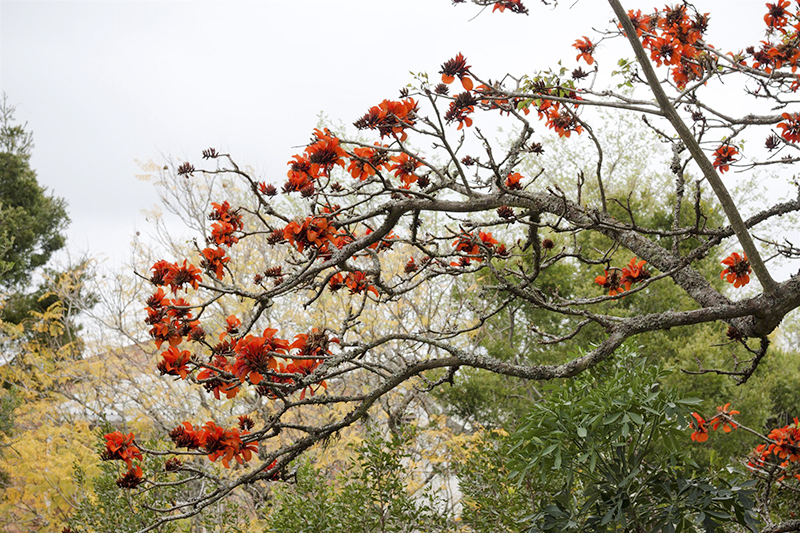This year, because of the dry seasons we have experienced, the magnificent trees in the gardens of Makhanda (Grahamstown) and along the streets are flowering profusely. Usually a prolonged dry spell of some months followed by some good rains is the best conditions for good flowering. This year we had good rains in summer and autumn followed by low rainfall in the winter and spring which has resulted in a welcome show to our pot-holed streets.
In July the numerous coastal coral trees (Erythrina cafra) started flowering. Outside the Albany Club, on High Street and outside the magisterial court building, are some fine specimens of coral trees which produced masses of coral-coloured flowers in July and August. As a member of the legume family, the tree also produces many small so-called lucky beans, which are black and red in colour. Pods are abundant on trees now, in December. The English oak (Quercus robor) was a popular street tree choice among the settlers but, the catkins although produced in abundance are a light yellow in colour and almost inconspicuous as it is a wind pollinated tree.
The yellow flowered silky oaks (Grevillea robusta) (Proteaceae from Australia) have been planted along the pavement on Hill and George Streets and elsewhere. They were spectacular in September and October but are almost past their peak now.
Why are there so many different species of trees on our streets? In 1876 the Tree Planting Act was passed, whereby the government subsidised half the cost of planting trees. But prior to this, in 1872, a city councillor Walter Smith took on the responsibility of planting 2000 street trees, 1500 “fir” trees on then undeveloped West Hill (in 1877), and 20 000 trees on the commonage (in the 1880s). Unfortunately, these trees were not good timber producers and some are invasive aliens, whose progeny are currently being removed. Later the Grahamstown Journal also attributed the “civic leafiness” of Grahamstown to CH Huntley (a city councillor).
The Cape chestnut (Calodendrum capense), an indigenous forest tree, is often stunted when grown along streets (there are a number in High and Bathurst Streets), but in between the months of October to December they are covered with masses of pink flowers, this year in profusion.
There are also two attractive flowering trees from Australia – the white-flowering kurrajong (Brachychiton populneus) is seen along the High Street. Its close relative, the Australian flame tree (Brachychiton acerifolius) has glossy dark green leaves and brilliant red flowers that are particularly showy at present in November and December. It will produce many persistent clusters of canoe-shaped pods later.
Finally the jacaranda trees (Jacaranda mimosifolia), which always produces a mass of purple flowers in December is gracing our streets and gardens with its blooms. It comes from sites closer to the equator in South America, and it has peak flowering times from Harare (August), Pretoria where it is most notable as the dominant street tree (September), Johannesburg (October) and Grahamstown (late November and December).
It is not only the street trees that are flowering spectacularly this year. In our garden at Waterloo Farm, the Bella ombre (Phytolacca dioica) produced numerous spikes of white flowers that littered the lawn. This tree, also from South America, is present on almost every settler farm as it was well dispersed by truncheon- (branch) planting in the nineteenth century. The bougainvilleas (also from Brazil and west to Peru) are also producing magnificent blooms this year in the Rhodes University and other gardens as are a myriad of indigenous plants species.
Perhaps not as spectacular in November 2018 is the indigenous ragwort, “inkanga”, or Senecio pterophorus, which is a bushy plant which produces masses of yellow flowers in November, hence the Xhosa name for November, “inyanga yeNkanga”. It is a pioneer of disturbed areas and this year it may just be a little late in appearing.
So keep your eyes off the potholes in the roads and enjoy our spectacular trees in bloom this year.
Large parts of the text extracted from the Tree Trails chapter of the soon to be published Grahamstown: a Guide to the Natural and Cultural History by the local branch of WESSA. Contact: Roy Lubke for more information (r.lubke@ru.ac.za)


